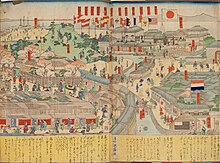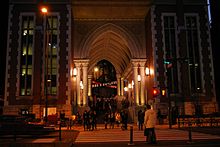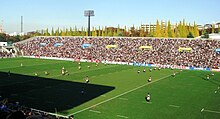
A | B | C | D | E | F | G | H | CH | I | J | K | L | M | N | O | P | Q | R | S | T | U | V | W | X | Y | Z | 0 | 1 | 2 | 3 | 4 | 5 | 6 | 7 | 8 | 9
This article contains content that is written like an advertisement. (May 2024) |
慶應義塾大学 | |||||
 | |||||
| Latin: Universitas Keio | |||||
| Motto | ペンは剣よりも強し Calamus Gladio Fortior | ||||
|---|---|---|---|---|---|
Motto in English | 'The pen is mightier than the sword' | ||||
| Type | Private; Research University | ||||
| Established | 23 April 1858 | ||||
| Founder | Fukuzawa Yukichi | ||||
| Affiliation | AACSB, APRU, CEMS – The Global Alliance in Management Education, COBS, ASAIHL | ||||
| President | Kohei Itoh | ||||
Academic staff | 2,791 full-time (As of May 1, 2022)[1] | ||||
Administrative staff | 3,252 full-time (As of May 1, 2022)[2] | ||||
| Students | 33,437 (As of May 1, 2022)[3][needs update] | ||||
| Undergraduates | 28,641 (As of May 1, 2022)[3][needs update] | ||||
| Postgraduates | 6,222 (As of May 1, 2022)[3][needs update] | ||||
| Location | , Tokyo , Japan | ||||
| Campus | Urban | ||||
| Flag |  | ||||
| Colors | Gold, Navy Blue, and Red | ||||
| Mascot | Keio Unicorn | ||||
| Athletics | 43 Varsity Teams | ||||
| Website | keio.ac.jp | ||||
 | |||||
| Japanese name | |||||
| Kanji | 慶應義塾大学 | ||||
| Hiragana | けいおうぎじゅく | ||||
| |||||
Keio University (慶應義塾大学, Keiō Gijuku Daigaku), abbreviated as Keio (慶應) or Keidai (慶大), is a private research university located in Minato, Tokyo, Japan.
It is the oldest institute of western higher education in Japan. Its founder, Fukuzawa Yukichi, originally established it as a school for Western studies in 1858 in Edo. It was granted university status in 1920, becoming one of the first private universities in the country.
The university is one of the members of the Top Global University Project (Top Type), funded by the Japanese Ministry of Education, Culture, Sports, Science and Technology.[4] Keio University is also one of the member universities of RU11[5] and APRU, and it is one of two Japanese universities (alongside the University of Tokyo) to be a member of the World Economic Forum's Global University Leaders Forum.[6]
Overview


Keio traces its history to 1858 when Fukuzawa Yukichi, who had studied the Western educational system at Brown University in the United States, started to teach Dutch while he was a guest of the Okudaira family. In 1868 he changed the name of the school to Keio Gijuku and devoted his time to education. While Keio's initial identity was that of a private school of Western studies, it expanded and established its first university faculty in 1890. It was the first Japanese university to reach its 150th anniversary in 2008.[citation needed]
Keio has approximately 30 Research Centres located on its five main campuses and at other facilities for advanced research in Japan.[7] Keio University Research Institute at SFC (KRIS) has joined the MIT and the French INRIA in hosting the international W3C.[8]
As of June 2022, Keio University holds the largest endowment fund among all Japanese universities, with ¥78 billion. This is followed by Waseda University at ¥29 billion, Kyoto University at ¥20 billion and the University of Tokyo at ¥15 billion.[9]
History

Keio University (慶應義塾大学, Keiō Gijuku Daigaku) was first established in 1858 as a School of Western studies located in one of the mansion houses at Tsukiji by founder Fukuzawa Yukichi.[10] Its root is considered as the Han school for Kokugaku studies named Shinshu Kan established in 1796.[citation needed] It later changed its name to "Keio Gijuku" in 1868, which originated from the era name "Keio",[11] with "Gijuku" as the translation of Private school.[12] It moved to its current location in 1871, established a Medical school in 1873, along with the university department of Economics, Law and Literacy studies in 1890.[citation needed]
| Year | University Development |
|---|---|
| 1858 | Establishment of Keio Gijuku |
| 1879 | Keio rejected an offer to become a national university.[citation needed] Instead, it became a vocational school funded by daimyōs including Shimazu clan. |
| 1890 | Departments of Economics, Law, and Letters established |
| 1906 | Graduate studies programs established |
| 1917 | School of Medicine established |
| 1920 | Keio authorized as a university in the prewar system |
| 1944 | School of Technology established |
| 1949 | Keio authorized as a university in the post-war system |
| 1957 | School of Business and Commerce established |
| 1962 | Graduate School of Business Administration established |
| 1981 | Department of Science and Technology established |
| 1990 | School of Environmental and Information Studies and School of Policy Management established |
| 2001 | School of Nursing and Medical Care established |
| 2004 | School of Law established |
| 2008 | School of Pharmacy established |
| 2008 | Graduate School of Media Design established |
In 1886, Keio University named Hiromoto Watanabe as the first chancellor of the Imperial University (University of Tokyo). Watanabe was the first chancellor of an officially authorised university in Japan.[citation needed] In 1899, Keio sent 6 students to study abroad. In the same year, it also accepted three international students from India, Qing-dynasty China, and Thailand. Eight international students entered from Taiwan (which had technically been a territory of the Japanese Empire since 1895) the following year. In 1946, Keio University began accepting female students.[citation needed] In 2006, a paper was published in the research journal Science with an undergraduate as its first listed author.[13]
In 1916, Keio was visited by Bengali poet Rabindranath Tagore. Another visit in 1922 included physicist Albert Einstein, who presented a special lecture on the theory of relativity.[14][15] In 2008, Keio University was visited by Prince Charles. In 2023, Sam Altman provided a lecture on campus.[citation needed]

Presidents
Since the president system was established in 1881, Keio University has had 20 presidents.[16]
| President | Tenure | President | Tenure | President | Tenure | President | Tenure | ||||
|---|---|---|---|---|---|---|---|---|---|---|---|
| 1. | Sadashiro Hamano | 1881–1887 | 7. | Shinzo Koizumi | 1933–1947 | 13. | Saku Sato | 1969–1973 | 19. | Akira Haseyama | 2017–2021 |
| 2. | Nobukichi Koizumi | 1887–1890 | 8. | Seiichiro Takahashi | 1946–1947 | 14. | Hiroshi Kuno | 1973–1977 | 20. | Kohei Itoh | 2021– |
| 3. | Tokujiro Obata | 1890–1897 | 9. | Kouji Ushioda | 1947–1956 | 15. | Tadao Ishikawa | 1977–1993 | |||
| 4. | Eikichi Kamata | 1898–1922 | 10. | Fukutaro Okui | 1956–1960 | 16. | Yasuhiko Torii | 1993–2001 | |||
| 5. | Ichitaro Fukuzawa | 1922–1923 | 11. | Shohei Takamura | 1960–1965 | 17. | Yuichiro Anzai | 2001–2009 | |||
| 6. | Kiroku Hayashi | 1923–1933 | 12. | Kunio Nagasawa | 1965–1969 | 18. | Atsushi Seike | 2009–2017 |
Student body
This section needs to be updated. (June 2023) |
In 2021, there were 33,469 students at Keio University, with 28,667 undergraduate students and 4,802 graduate students. Although two-thirds of the student body are males, the gender ratio differs between different majors (e.g. 56% of students are female in the Faculty of Letters, whereas in the School of Medicine, three-quarters of students are men.).[3]
| Undergraduate | Graduate (Master) | Graduate (Doctor) | Professional | Total | |
|---|---|---|---|---|---|
| Total | 28,667 | 3,034 | 1,408 | 360 | 33,469 |
| Male | 18,346 | 2,044 | 985 | 228 | 21,603 |
| Female | 10,321 | 990 | 423 | 132 | 11,866 |
| International | 874 | 861 | 1,735 | ||
There were 1,908 international students on May 1, 2021, with 874 undergraduate students (3.1% of total undergraduate students (=28,667)), 861 graduate students (18.0% of total graduate students (=4,802) ) and 173 other students.[17] China provided the most international students with 1,016, followed by South Korea (436), France (66), Taiwan (51), the United States (36), Indonesia (34), and Germany (29).[17]
Student life

Societies
In Japanese universities, student societies are known as "circles". There are over 410 circles at Keio University by estimate, including both official and unofficial circles.[18]
Athletics
The interest of Keio's students in baseball stretches back to the early years of the 20th century. In 1913, an American touring team of players from the New York Giants and the Chicago White Sox played an exhibition game against the Keio team.[19] In a 1932 exhibition game, the Keio team beat the University of Michigan team, which was then touring Japan.[20] Keio's baseball team plays in the Tokyo Big6 Baseball League.
Kei-So rivalry

Traditionally, there has been a strong rivalry between Keio and Waseda University. There are annually many matches between the two universities in several sports, such as baseball, rowing, rugby, lacrosse, track and field, American football, association football, aikido, karate, basketball, tennis, swimming, fencing, figure skating, ice hockey, and field hockey. These games are called "Kei–So Sen (慶早戦)" or, more generally, "So–Kei Sen (早慶戦)".
The Kei-So baseball rivalry, which dates back more than a century, is especially famous because of its importance in Japanese baseball history. The most famous Kei-So baseball game, which was played on October 16, 1943, was made into a movie titled "The Last Game – the Final So-Kei Sen -" in 2008.
American football
Scandals
In October 2016, six male students from Keio Advertisement Society, a long-standing student club known for its organisation of the Miss Keio pageant contest, were investigated for gang rape during a club activity.[21] An out-of-court settlement was reached and the students were not prosecuted.[22] In May 2018, another three students were arrested for sexual assaults.[23]
In March 2017, a student tennis club was disbanded after a student died of alcohol poisoning during a club activity. Two other Keio students died due to over-drinking in 2012 and 2013.[24]
In June 2017, the school's election committee unconventionally selected Haseyama Akira, a legal history professor who won second place at the general election among teachers and staff, to be the school's new president, breaking a 50-year convention.[25]
In late 2019, both the American football team and the cheerleading club suspended club activities for "inappropriate behaviours".[26][27]
In January 2020, it was reported that a former member of the school president's secretarial staff had installed a camera in a female toilet stall on the Mita campus, filming over a thousand videos over 3 months.[28][29]
